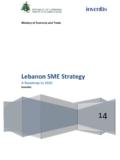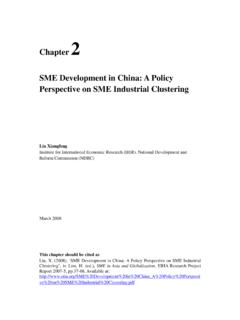Transcription of Financing a New Venture - Innovation Centre
1 1 CIC 2011 a New VentureA Canadian Innovation CentreHow-To Guide2 CIC 2011 a new Venture New ventures require Financing to fund growth Forms of Financing include equity (personal, family & friends, VC, angel) and debt (generally family & friends, banks or government agencies) The amount of Financing required is driven by the cumulativenegative cash flow of the business The appropriate mix of Financing vehicles changes with time and the life cycle of the Venture The choice of Financing vehicles is important, as it affectsboth control of the business and business strategy Securing Financing is an almost continuous activity forhigh growth new ventures3 CIC 2011 Equity: shares in the company, issued to the founder or investors Sweat equity: investment by founders in form of labour Early-stage or seed Financing : one of the first financings obtained by the company A, B or C round Financing : levels of Venture investments IPO:initial public offering on a public exchange Private placement:selling shares which can not be traded Debt: loans to the company, that carry a payback period and interest rate Convertible debentures:debt issued that can be converted to equity at a future date Liquidity event:selling the majority of shares in the business to provide a financial return to the investors (either through acquisition or IPO) Acquisition.
2 When company is purchased by or buys another company4 CIC 2011 of cash flows Most new ventures fail because they run out of cash Negative cash flow can be associated with money losing companies, or companies with very high growth rates Cash flows are cumulative, so total negative cash flow is total of all cash flows in previous periods plus negative cash flow in that period Companies must develop a plan to cover the maximum cumulative negative cash flow This plan can include various sources of finance (and a mixture of debt and equity) and can occur over time (to match the negative cash flow requirements) Biggest issue is not planning for negative cash flow and then running out of money5 CIC 2011 $700,000$600,000$500,000$400,000$300,000 $200,000$100,000$0$100,000$200,000$300,0 00012345678 Annual Cash FlowCumulative cash flowAn example of a cumulative cash flows If annual sales growth is greater than gross margin, then the company will always be short of cash 6 CIC 2011 key cash flow driversRelationship with Cash Growthusually Margin % (Gross Profit/Sales) , General and Administration (SGA) as % of Salesnegative Expense Tax Collection Period (ACP)
3 Negative Conversion Payable Capital s Withdrawals from Firmnegative7 CIC 2011 much money should you raise and when should you raise it Your funding plan should show you know how to raise enough money to covertotal cumulative negative cash flow Each source of funding must see other potential sources offunds, so that they know the company will not fail, and that they are not the only source When raising debt, actual timing isnot that important, but you need to do it before you need the money (and raise it in tranches to meet negative cash flows not sit in bank account) When raising equity,first money raised is the most expensive -therefore you should raise the minimum necessary to get you to the point where there is an increase in business value You should be prudent and not run out of money, this can be a fatal error (Remember everything takeslonger than you expect and costsmore)8 CIC 2011 are the points at whichcompany value increases?
4 These milestones are externally verifiable and can be used as points when already raised money can be issues, or subsequent rounds of finance obtained Proof of principle Prototype Strategic partner Patent issued or license granted First customer Distributor Third party validation9 CIC 2011 theinitial amount required, and how much equity is given upHow to reduce investment required: Invest in stages Reduce amount spent Extended payment terms to suppliers Get up front payments from customers Create R&D consortium Leverage existing development work Obtain government grantsPotential downsides of less investment May reduce likelihood of success May increase time to market May allow competitors into market space10 CIC 2011 versus Equity financingDebt Obtaining borrowed funds for the company Interest bearing instrument; loan Asset-based Financing needs collateral Short-term borrowing for working capital Long-term borrowing for capital items Sacrifices cash flow for ownership controlEquity Obtaining funds for the company in exchange for ownership No collateral required Investors share in the profits of the Venture Issue of control when ownership is diluted Canadian SME s prefer debt Financing over equity Financing by a large margin11 CIC 2011 sources of Financing Self Family and Friends Suppliers and trade credit Commercial banks Government loan programs Strategic partners Angel investors Venture capitalists Other government programs12 CIC 2011 Business Start-up Angels Government programmes First Stage Expansion Some Venture Capital Bank Financing Second Stage Expansion Private Placement Institutional Venture Capital Concept Stage Self Family and friends Time Third Stage Expansion Acquisition IPOS ources of
5 Equity finance over lifecycle13 CIC 2011 of personal funds 2/3 of start-ups use personal savings 3 of 4 most common Financing strategies involve personal guarantees Least expensive source of funds and most control Essential to attracting outside funding Personal funds invested are a sign of commitment by the entrepreneur sources are: savings, life insurance, investments, mortgage, credit cards, lines of credit14 CIC 2011 14 Commercial Banks and their loansCommercial banks are the most frequently used source of short-term funds accounts receivable loans inventory loans equipment loans real estate loans lines of credit installment loans SRED loans contract financing15 CIC 2011 fundsBusiness Development bank of Canada (BDC) Offers financial products, consulting services, and Venture capital to SME s Loans have less stringent requirements, more flexible repayment, and use viability as main funding criteriaNRC IRAP Grants for R&D but some are repayableRevenue Canada Refunds 35-40% of eligible R&D expenses Refund in the form of cash (can be collateralized)
6 Export Development Corporation Accounts receivable insurance Contract and working capital financingSmall business loan Administered by banks on up to $150,000 for eligible fixed assets16 CIC 2011 Investors Angel investors are wealthy individuals investing their own money They are motivated not only by a financial return but a desire to help others and have an impact There are approximately 200,000 in Canada They have an average age of 47, net worth of C$ million, Most have previous entrepreneurial experience Invest about once per year and reject 97% of applications Average investment is $110,000 53% of investments are made within 50 miles of their home Compatibility with owners of business is critical given that investment firm is illiquid Importantly they see their role as complementing that of the entrepreneurs and their team17 CIC 2011 Investment decision making process -Informal The only thing more difficult than finding an angel is successfully negotiating a deal with one As they are only accountable to themselves, it is difficult to say in a specific instance what are the criteria for success.
7 However research in the decision making process has led us to conclude the following factors can increase the chance of a successful investment: Prepare properly and know you plan and your numbers in advance Find them through a referral and screen them for fit Make sure you have thought out how much money you need and what you will use it for Be prepared to negotiate and understand what you will have to give up to engage them (and the benefits of this) Have references ready -they will find a way to check them18 CIC 2011 Capitalists (VCs) Firm of professionals who manage pool of equity capital on behalf of other investors ( pension funds) The firm is paid both on the basis of funds invested and successful exists -Management expense and profit Each fund has investment time horizon, which affects their decision making as well as areas of specialization While some VCs invest in businesses at all stages of development other specialize (seed or mezzanine)
8 At time of investment need to understand liquidity event Importantly they see their role as replacing the entrepreneurs and their team if necessary19 CIC 2011 Capital decision making process -More formal VCs are accountable to investors and therefore need to both justify their investment decision making process and demonstrate it fits within the mandate of the fund. Research in the VC decision making process has led us to conclude the following factors can increase the chance of a successful investment: Prepare properly and know you plan and your numbers in advance Find them through a referral and ensure you meet their investment criteria Think out how much money you need and when, what you will use it for and what you could do if you had more Be prepared to negotiate and understand what you will have to give up to engage them along with all the detailed terms in a VC contract Have references (often customers)
9 And other legal documents ready -they will want to check them20 CIC 2011 versus VCs Angels make about 30 times as many investments as VCs Angels tend to invest in smaller amounts or syndicate for larger investments Angels tend to become much more involved with their seed ventures often working alongside entrepreneur VCs can not spend as much time with seed companies, but are usually well linked to follow on Financing Over 70% of VC investments are subsequent to an Angel investment21 CIC 2011 much will you have to give up?The basic rule is simple: Decide how much money you need now -$X Decide how much the company is worth now -$Y Assume that post investment the company is worth$(X + Y) -remember the money goes into the company not to the entrepreneur The percentage you have to give up is X/(X+Y)If you need $300K and your company is worth $500K before the investment, then after the investment it is worth $(X+Y) = $800kThe investor wants $300k/$800k or CIC 2011 the companyFor new ventures there are three basic ways to value company (lowest to highest).
10 Market price of similar company s stock (P/E ratio) based on profit forecast in 3 5 years Net present value (NPV) of cash flows, assuming positive Strategic value, based on assumptions of value firm brings to an acquirer (in reality this is most important in Canada as 80% of funded firms are acquired)23 CIC 2011 price of similar company s stock Create a 5 year profit and loss pro-forma Identify profit in year 5 (example $1 million) Select industry sector based on stock exchange indices Look at either industry average or most similar company P/E ratio from that sector Multiply your forecast by that Industry P/E 15 , so your value would be $15m24 CIC 2011 present value of free cash flow With the free cash valuation approach, the firm s value equals the present value of cash flows that will ultimately flow from the firm to the debt holders and shareholders who finance the cash flows are expected to arise from 1)normal operation of the firm 2)liquidation of redundant assets and be reduced by investments in new assets needed to maintain and grow CIC 2011 discounted cash flows How do we calculate the value today of money in the future They depend on interest rates If interest rates are 10%, then $100now is the same as $110in the future (ignoring taxes) $100* (1 + ) = $110 Similarly $110/ (1+ )








